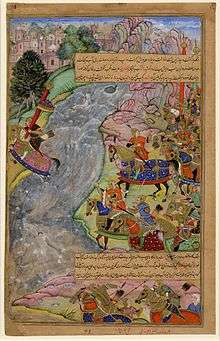Jalal ad-Din Mingburnu
| Mingburnu | |||||
|---|---|---|---|---|---|
|
Monument of Jalal ad-Din Mingburnu in Urgench | |||||
| Reign | 1220 – 1231 | ||||
| Predecessor | Muhammad II | ||||
| Successor | None | ||||
| Born | 1199[1] | ||||
| Died | 1231 | ||||
| Spouse |
Melika Khatun Terken Khatun Fulana Khatun | ||||
| Issue |
Manqatuy-Shah Qaymaqar-Shah | ||||
| |||||
| House | House of Anushtegin | ||||
| Father | Muhammad II | ||||
| Mother | Ay-Chichek | ||||
| Religion | Islam | ||||

Jalal ad-Din Mingburnu (Persian: جلال الدین خوارزمشاه; Turkmen: Jelaleddin Meňburun or Jelaleddin Horezmşa; full name: Jalal ad-Dunya wa ad-Din Abul-Muzaffar Manguberdi ibn Muhammad) or Manguberdi (Turkic for "Godgiven"), also known as Jalâl ad-Dîn Khwârazmshâh, was the last ruler of the Khwarezmian Empire.
Biography
Following the defeat of his father, Ala ad-Din Muhammad II by Genghis Khan in 1220, Jalal ad-Din Mengübirti came to power but he rejected the title shah that his father had assumed and called himself simply sultan. Jalal ad-Din retreated with the remaining Khwarazm forces, while pursued by a Mongol army and at the battle of Parwan, north of Kabul, defeated the Mongols.[2]
Due to the Mongol invasion, the sacking of Samarkand and being deserted by his Afghan allies, Jalal ad-Din was forced to flee to India.[3] At the Indus River, however, the Mongols caught up with him and slaughtered his forces, along with thousands of refugees, at the Battle of Indus. He escaped and sought asylum in the Sultanate of Delhi but Iltutmish denied this to him in deference to the relationship with the Abbasid caliphs.
Jalal ad-Din Mingburnu spent three years in exile in India. Mingburnu entered into an alliance with the Khokhars and captured Lahore and much of the Punjab. He requested an alliance with Iltutmish against the Mongols. The Sultan of Delhi refused so he could avoid a conflict with Genghis Khan and marched towards Lahore at the head of a large army. Mingburnu retreated from Lahore and moved towards Uchch inflicting a heavy defeat on its ruler Nasir-ud-Din Qabacha, and plundered Sindh and northern Gujarat before returning to Persia in 1224.[4]

He gathered an army and re-established a kingdom. He never consolidated his power however, and he spent the rest of his days struggling against the Mongols, pretenders to the throne and the Seljuk Turks of Rum. He lost his power over Persia in a battle against the Mongols in the Alborz mountains and fled to the Caucasus to capture Azerbaijan in 1225, setting up their capital at Tabriz. In 1226 he attacked Georgia and sacked Tbilisi, destroying all the churches and massacring the city's Christian population.[5]
Jalal ad-Din had a brief victory over the Seljuks and captured the town Akhlat from Ayyubids. However, he was later defeated by Sultan Kayqubad I at Erzincan on the Upper Euphrates at the Battle of Yassıçemen (Yassi Chemen) in 1230, from where he escaped to Diyarbakir while the Mongols captured Azerbaijan in the ensuing confusion. He was murdered in 1231 in Diyarbakir by a Kurdish man.[6][7]
References
- ↑ ru:Джелал ад-Дин Манкбурны
- ↑ John Man, Genghis Khan: Life, Death, and Resurrection, (St.Martin's Press, 1994), 181.
- ↑ Trevor N. Dupuy and R. Ernest Dupuy, The Harpers Encyclopedia of Military History, (Harper Collins Publishers, 1993), 366.
- ↑ Chandra, Satish (2004), Medieval India: From Sultanat to the Mughals-Delhi Sultanat (1206-1526) - Part One, Har-Anand Publications, p. 40.
- ↑ Grousset, Rene, The Empire of the Steppes, (Rutgers University Press, 1991), 260
- ↑ , PHI, Persian Literature in Translation
- ↑ , Encyclopedia Iranica
Sources
- Grousset, Rene, The Empire of the Steppes, Rutgers University Press, 1991
| Preceded by Muhammad II |
Sultan of the Khwarezmian Empire 1220–1231 |
Succeeded by Mongol conquest |